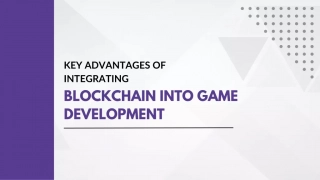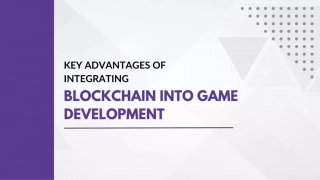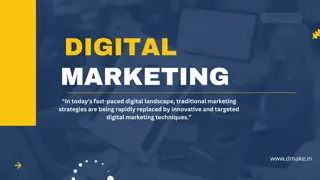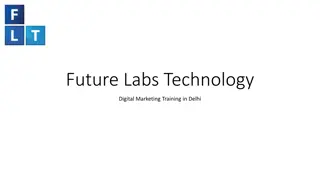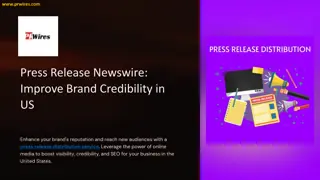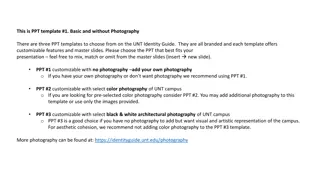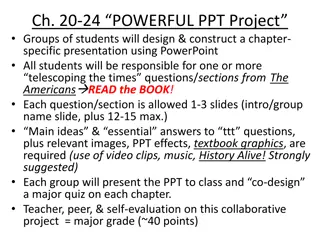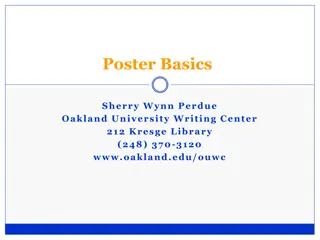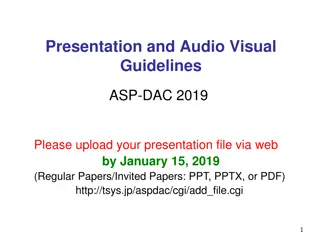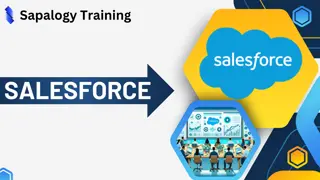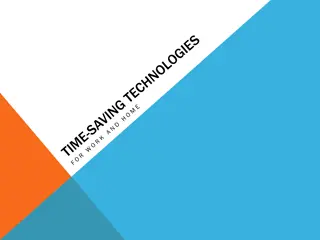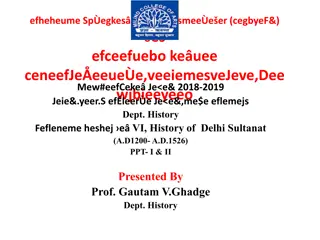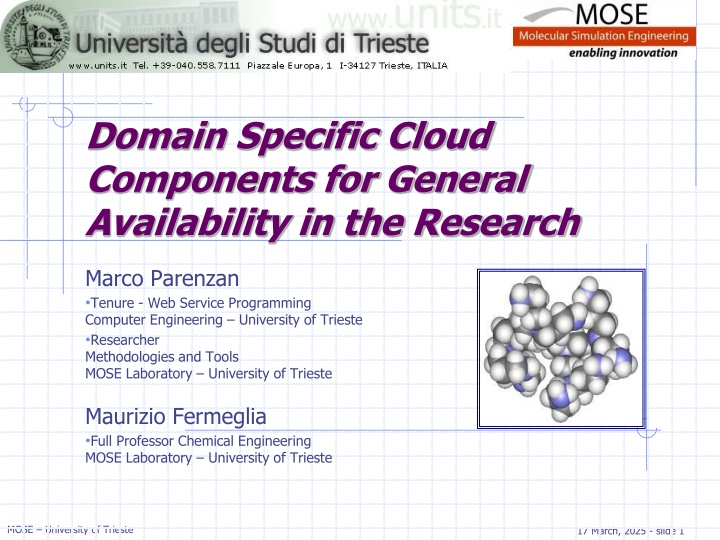
Revolutionizing Research with Multiscale Molecular Modeling
In a groundbreaking presentation at the University of Trieste, MOSE Laboratory introduces its cutting-edge Molecular Simulation Engineering (MOSE) vision. Through multiscale molecular modeling, MOSE aims to accelerate product development in various fields such as material sciences, life sciences, and process simulation. The presentation delves into the characteristic time and length scales of engineering design, emphasizing the transformative potential of this approach. However, challenges in cloud-based deployment are noted due to software dependencies.
Download Presentation

Please find below an Image/Link to download the presentation.
The content on the website is provided AS IS for your information and personal use only. It may not be sold, licensed, or shared on other websites without obtaining consent from the author. If you encounter any issues during the download, it is possible that the publisher has removed the file from their server.
You are allowed to download the files provided on this website for personal or commercial use, subject to the condition that they are used lawfully. All files are the property of their respective owners.
The content on the website is provided AS IS for your information and personal use only. It may not be sold, licensed, or shared on other websites without obtaining consent from the author.
E N D
Presentation Transcript
Domain Specific Cloud Components for General Availability in the Research Marco Parenzan Tenure - Web Service Programming Computer Engineering University of Trieste Researcher Methodologies and Tools MOSE Laboratory University of Trieste Maurizio Fermeglia Full Professor Chemical Engineering MOSE Laboratory University of Trieste MOSE University of Trieste 17 March, 2025 - slide 1
MOSE: Molecular Simulation Engineering Vision Multi Scale Molecular Modeling will revolution the world of research and industrial production in the next years by strongly accelerating the development of new products. Mission Material Sciences: thermo physical properties for materials, polymer technology and nanoscience/nanotechnology Life Sciences: drug-receptor interactions, drug-design, QSAR, drug- delivery Process simulation: process synthesis, design, modeling for chemical, biochemical, energy production S03 S09 S08 S02 COL1 S01 MAKUPB COL2 S05 H3 T1 H1 P1 S13Z MAKUPA S12 F1 Q1 S07 S10 M1 S06 H2 H4 S14 S13 MOSE University of Trieste 17 March, 2025 - slide 2 S04 S11
Multiscale Molecular Modeling Characteristic Time Engineering design Engineering design years hours Simulazione di processo FEM Process Simulation minutes Mesoscale modeling (segments) seconds FEM microseconds Meccanica molecolare (atomi) Molecular Mechanics (atoms) nanoseconds Quantum Mechanics Meccanica Quantistica (elettroni) (electrons) picoseconds femtoseconds 1 m 1 m 1 1 1nm 1nm 1mm 1mm 1m 1m Characteristic Length MOSE University of Trieste 17 March, 2025 - slide 3
Message Passing Multiscale Molecular Modeling Engineering design Process Simulation FEM Mesoscale modeling (segments) Molecular Mechanics (atoms) Quantum Mechanics Meccanica Quantistica (elettroni) (electrons) MOSE University of Trieste 17 March, 2025 - slide 4
Cloud-based Message Passing for Multiscale Molecular Modeling Engineering design Engineering design Quantum Mechanics (electrons) Process Simulation FEM Simulazione di processo FEM Meccanica molecolare (atomi) Mesoscale modeling (segments) MOSE University of Trieste 17 March, 2025 - slide 5
MOSE in the cloud no. Why? Because it heavily depends on software (molecular simulation, process simulation) that are not on the Cloud Does MOSE needs the Cloud? Yes. People need sharing the knowledge based on simulation and, generally, on computation Can MOSE access alone the Cloud? No, at the moment The actors: Chemists, Chemical Engineers, Materials Engineers, Biologists, Medical Doctors Just Computer Science classes in the first two years of Engineering Curriculum (some C/C++, no VB(A) or .NET, some Matlab) But they need programs to solve their problems and sometimes they try to write them! MOSE University of Trieste 17 March, 2025 - slide 6
Objectives of this Research Move MOSE to the Cloud! Cannot wait software companies Computer engineers can simplify write these codes But she needs speaking with (non-computer) engineers about the details (Analysis, Specifications, DOMAIN ) Why don t we enable (non-computer) scientists writing their own code? Simplifying (programming) tools to consume the Cloud What does consume mean? Write Algorithms Write Plug ins for existing apps Write Custom Programs MOSE University of Trieste 17 March, 2025 - slide 7
Simplification development path We are still @ C++ (some apps need C++ plug in/custom code) We already stepped into CLR world Example our development in CAPE-OPEN (http://co-lan.org) The next step are Dynamic Languages such as Python or Ruby DSLs world for data (custom data texts) Win32 CLR DLR DSL C/C++ C#/VB Python/Ruby Custom DSL MOSE University of Trieste 17 March, 2025 - slide 8
Dynamic Languages on .NET IronRuby C# VB.NET Others IronPython Dynamic Language Runtime Expression Trees Dynamic Dispatch Call Site Caching Python binder JavaScript binder Object binder Ruby binder COM binder MOSE University of Trieste 17 March, 2025 - slide 9
Why should we care then? More languages, more options DLR gives apps instant scripting abilities C# has moved in that direction too! LINQ Lambda expressions Parallel extensions (C# 4.0) dynamic (C# 4.0) and var keywords C# 4.0 Dynamic Programming C# 3.0 Language Integrated Query C# 2.0 Generics C# 1.0 Managed Code MOSE University of Trieste 17 March, 2025 - slide 10
What is "Oslo"? THE PLATFORM FOR MODEL-DRIVEN APPLICATIONS M The language for authoring models & DSLs Quadrant The tool for interacting with models & DSLs Repository The database for storing & sharing models MOSE University of Trieste 17 March, 2025 - slide 11
"Oslo" Architecture QUADRANT [Your Visual DSL] [Your Textual DSL] EDITOR LANGUAGE FRAMEWORK FRAMEWORK Composition MSchema RUNTIMES Generic Viewers MGrammar [Your Runtime] Dataflow MGraph XML, Custom Formats, Dublin ASP.NET WF ADO .NET WCF SQL/EDM REPOSITORY REPOSITORY REPOSITORY Windows SQL SERVER SQL SERVER SQL SERVER Other ISV Runtimes [Your Models] [Your Models] [Your Models] OTHER Base Models Base Models .Net Models XML, Custom Formats, TOOLS M Runtime M Runtime Repository Models (VSTS, EXCEL, ) MOSE University of Trieste 17 March, 2025 - slide 12
Storage in Windows Azure GOAL: SCALABLE, DURABLE STORAGE Tables: simply structured data, accessed using ADO.NET Data Services Queues: serially accessed messages or requests, allowing web-roles and worker- roles to interact Blobs: large, unstructured data (audio, video, etc) Windows Azure storage is an application managed by the Fabric Controller Windows Azure applications can use native storage or SQL Azure Application state is kept in storage services, so worker roles can replicate as needed MOSE University of Trieste 17 March, 2025 - slide 13
Simplification steps 1. Write apps running on cloud Windows Azure (ASP.NET MVC2) Web Role for the front-end Worker Role for background processing Table, Blob and Queue for unstructured , but easy, storage 2. Use Dynamic Languages to do the processing Simplified deployment Simplified code model Simplified type management (dynamic typing, no variable declaration) Now fully integrated in .NET with DLR and IronPython and IronRuby 3. Input and Output as structured text M (in Oslo , now SQL Server Modeling) gives us a generic schema language (more general that XSD) and more readable than xml This gives structure and metadata to the Azure Storage data (as requested by Ed Lazowska in his yesterday wonderful keynote) 1. 2. 3. 4. 1. 2. 3. 4. 1. 2. MOSE University of Trieste 17 March, 2025 - slide 14
Domain Specific Cloud Components for General Availability in the Research Demo MOSE University of Trieste 17 March, 2025 - slide 15
The matrix was too simple? This is a two-dimensional matrix of three dimensional vectors Size of cube is: 100 nano meters MOSE University of Trieste 17 March, 2025 - slide 16
Domain Specific Cloud Components for General Availability in the Research Conclusions MOSE University of Trieste 17 March, 2025 - slide 17
The results 1. Write apps running on cloud Windows Azure (ASP.NET MVC2) Web Role for the front-end Web Role for background processing 2. Use Dynamic Languages to do the processing Simplified deployment Simplified code model Simplified type management (dynamic typing, no variable declaration) Now fully integrated in .NET with DLR and IronPython and IronRuby 3. Input and Output as structured text Oslo (now SQL Server Modeling) gives us a generic schema language (more general that Xsd) and more readable than xml Structured text as data sources 1. 2. 3. 1. 2. 3. 4. 1. 2. MOSE University of Trieste 17 March, 2025 - slide 18
Conclusions Why MOSE needs the cloud? To build a platform to orchestrate the message passing in Multiscale Molecular Modeling activity To empower our research team with a flexible scientific platform that drives efficiency, collaboration and innovation In the demo we have seen The creation and the execution (invocation) of the single step of the process The input and the output are the messages that walk through the scale The code: Definition of a library of a generic cloud component Usage of Dynamic Languages (IronPython) A new opportunity in .NET development More productive (PLLs, as told by Armando Fox yesterday) More simpler for non programmers Application of DSLs (Oslo) for the definition of simple input/output messages More confident with scientific people More simple than a graphical UI to implement It gaves metadata/schema to flat files (as requested by Ed Lazowska in his yesterday wonderful keynote) What s next? MOSE University of Trieste 17 March, 2025 - slide 19
What is next? Continue with the project The definition of a process (an orchestration) Did you saw the session from Paul Watson yesterday? ( Cloud Computing from chemical Property Prediction ) The users in the process Collaboration in the process Again, as Paul said, we agree on a structure like a social science community , a Web 2.0 application Security, Confidentiality Verticalization on the domain Remove all the nitty-gritty details that lowers the experience Define custom component Languages MOSE University of Trieste 17 March, 2025 - slide 20
Simplification steps 1. Write apps running on cloud Windows Azure (ASP.NET MVC2) Web Role for the front-end Worker Role for background processing Table, Blob and Queue for unstructured , but easy, storage 2. Use Dynamic Languages to do the processing Simplified deployment Simplified code model Simplified type management (dynamic typing, no variable declaration) Now fully integrated in .NET with DLR and IronPython and IronRuby 3. Input and Output as structured text M (in Oslo , now SQL Server Modeling) gives us a generic schema language (more general that XSD) and more readable than xml This gives structure and metadata to the Azure Storage data 4. Write DSL 1. 2. 3. 4. 1. 2. 3. 4. 1. 2. MOSE University of Trieste 17 March, 2025 - slide 21
Writing a Custom DSL (Supposed)Needs of the non- programmer Libraries Integrated functionalities No include Data Access as Libraries Connect Command Execute LINQ Define Datasource (Metadata), no SQL schema All-in-one One Component, one file (as much as possible) Simplifing deployment Need of the programmer Not so (much) imperative, not so (much) functional, not so (much) object oriented State is not so bad Lambda are cool (no functions, all lambdas) Escape to power (if DSL is poor ) Backend of a full language, totally integrated DLR, (Iron)Python, (Iron)Ruby, (Iron)JS (Javascript) and so on cloud component #naming part (entry point) Name = "test 0004" # declarative part # sections like cobol input i(label = "Input Vector") data # static declaration m(name = "matrix01" # this is the "query" label = "multiplication matrix") output o(label = "Output Vector") # coding part # dynamic like python (and vb) # verbose like visual basic code "this is the main" # alterernative syntax of query from storage # calculated m = lookup in Matrici for NomeMatrice ### multiline comment ### assign 0 to r while r is less then m.rows do assign 0 to c assign 0nm to a while c is less then m.cols do #a = a + m(r,c) * i(c) increment a by m(r,c) * i(c) # python has no matrix, but jagged arrays increment c by 1 end do assign a to o increment r by 1 end do MOSE University of Trieste 17 March, 2025 - slide 22
Domain Specific Cloud Components for General Availability in the Research Q&A Marco Parenzan web presence Blog: http://blog.codeisvalue.com/ E-mail: marco.parenzan@libero.it Facebook: parenzan.marco Twitter: marco_parenzan Skype: marco.parenzan Live: marco.parenzan@live.it Slides: http://www.slideshare.com/marco.parenzan http://blog.codeisvalue.com/ marco.parenzan@libero.it marco.parenzan@live.it http://www.slideshare.com/marco.parenzan MOSE University of Trieste 17 March, 2025 - slide 23
MOSE: Molecular Simulation Engineering Department of Materials and Natural Resources (DMRN) University of Trieste Piazzale Europa 1, 34127 Trieste (Italy) http://www.mose.units.it/ http://www.mose.units.it/ maurizio.fermeglia@dicamp.units.it Maurizio Fermeglia maurizio.fermeglia@dicamp.units.it MOSE University of Trieste 17 March, 2025 - slide 24



